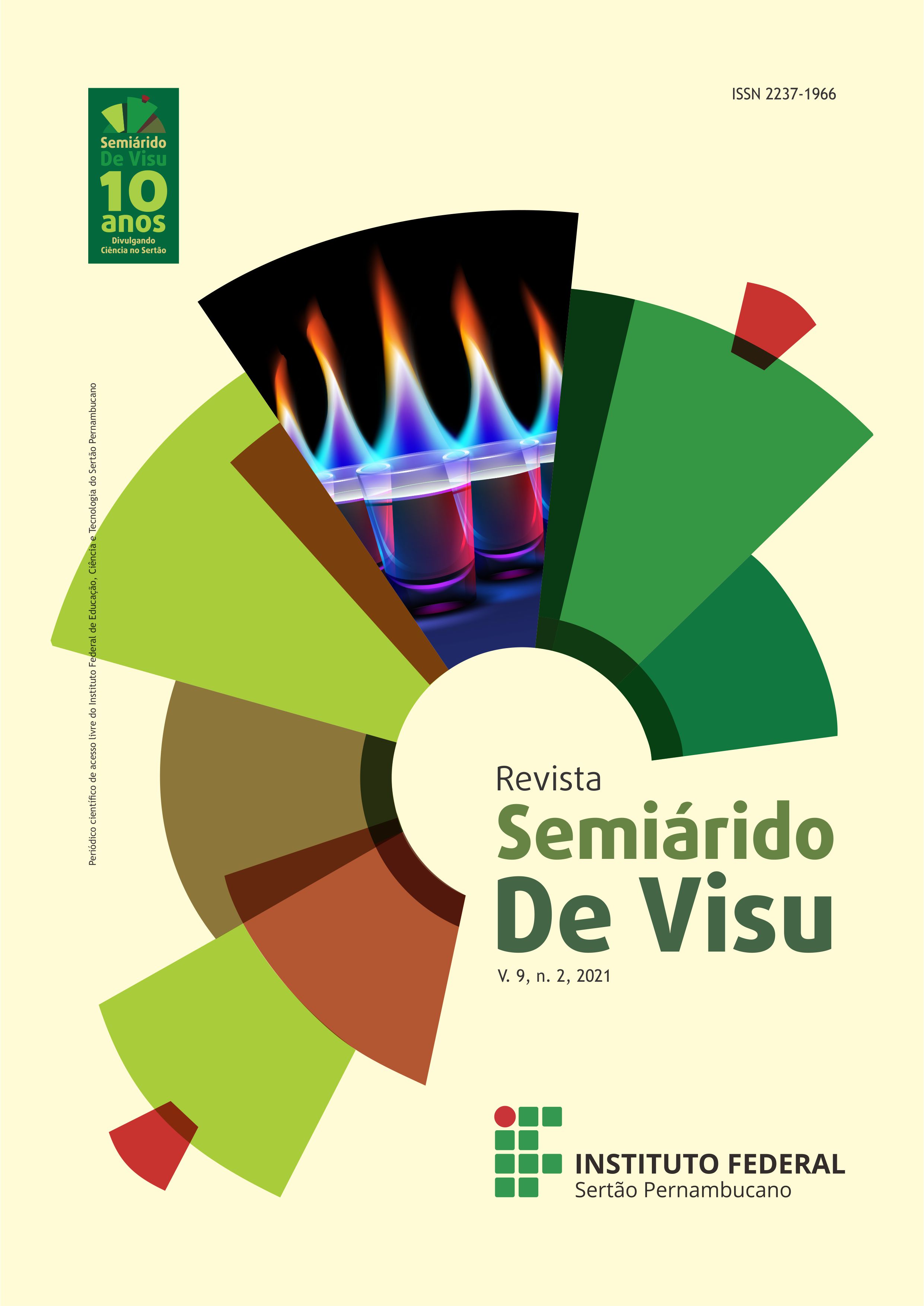Morphometric characterization of Garças River watershed in Pernambuco, Brazil
Visualizações: 941DOI:
https://doi.org/10.31416/rsdv.v9i2.236Keywords:
Geoprocessing, Brazilian Semiarid, Remote SensingAbstract
Morphometric analysis of watershed is of great importance for the understanding of their
hydrological behavior and the geoprocessing tools allow high precision and agility in these analyzes.
In this sense, this study consisted of a morphometric analysis of the Garças River Watershed (GRW),
Pernambuco, Brazil. SRTM data was processed in the QGIS and the TauDEM was used as a data
extraction tool. The most relevant results are the Kc value of 1.803, Kf of 0.244, and Ic of 0.303,
which indicates an elongated that favors GRW surface runoff. It should also be noted that the fluvial
hierarchy GRW is of 5th order, the values of Dd and Dh were low, 0.365, and 0.135, respectively,
and, in relation to the relief, the region has low slopes and low altitudes. In conclusion, it is
important to highlight the low propensity to flooding under normal rainfall conditions due to the
elongated of the basin. In contrast, the relief with low slopes does not favor the runoff. Finally, the
drainage parameters indicate that the hydrographic basin has poor drainage.
References
ABDETA, G. C., TESEMMA, A. B., TURA, A. L. & ATLABACHEW, G. H. Morphometric analysis for prioritizing sub-watersheds and management planningand practices in Gidabo Basin, Southern Rift Valley of Ethiopia.Applied Water Science, 10:1-15, 2020.
ABUD, E. A., LANI, J. L., ARAÚJO, E. A., AMARAL, E. F., BARDALES, N. G. & FERNANDES FILHO,E. I. F. Caracterização morfométrica das sub-bacias no município de Xapuri: subsídios à gestão territorial na Amazônia Ocidental.Revista Ambiente & Água,10:431-441, 2015.
ALTAF, F., MERAJ, G. & ROMSHOO, S. A. Morphometric Analysis to Infer Hydrological Behaviour of Lidder Watershed, Western Himalaya, India.Geography Journal, 2013:1-14, 2013.
CARVALHO, A. A., LOPES, I., SILVA, O. F. Observed Trends in Precipitation over the Riacho do Navio Basin (Pernambuco).Anuário do Instituto de Geociências -Ufrj, 42:56-70, 2019.
CHOUDHARI, P.P., NIGAM, G.K., SINGH, S.K. & THAKUR, S. Morphometric based prioritization of watershed for groundwater potential of Mula river basin, Maharashtra, India.Geology, Ecology, And Landscapes, 2:256-267, 2018.
CIRILO, J.A.Políticas públicas de recursos hídricos para o semiárido.Estudos Avançados, 22:61-82, 2008.
CORREIA, R. C., KIILL, L. H. P., MOURA, M. S. B., CUNHA, T. J. F., JESUS JÚNIOR, L. A. & ARAUJO, J. L. P. A região semiárida brasileira. In: Voltolini, T. V. (ed.). Produção de caprinos e ovinos no Semiárido.Embrapa Semiárido, 2011. p.21-48.
EMBRAPA -Empresa Brasileira de Pesquisa Agropecuária. Sistema Brasileiro de Classificação de Solos. Brasília Embrapa, 2018. 356 p.
FIDELES, D. M., PIRES, G. T., CERIGNONE, F. J., TAVARES, C. V. G. & RODRIGUES, V. A. Morphometric analysis of the watershed of Veloso and Café streams.Científica, 44:255-262, 2016.
HORTON, R.E. Drainage-basin characteristics.Transactions, American Geophysical Union, 13:350-361, 1932.
HORTON, R.E. Erosional development of streams and their drainage basins, hydrophysical approach to quantitative morphology. Bulletin of The Geological Society of America,56:275-370, 1945.
IBGE. Instituto Brasileiro de Geografia e Estatística. Disponível em: <ftp://geoftp.ibge.gov.br/cartas_e_mapas/bases_cartograficas_continuas/bc250/versao2019/>. Acesso em: 05 jun. 2020.
LIRA, F. A., CARDOSO, A. de O. Estudo de tendência de vazões de rios das principais bacias hidrográficas brasileiras. Revista Brasileira de Ciências Ambientais, 21-37, 2018.
LOPES, I., RAMOS, C. M. C. & LEAL, B. G. Caracterização morfométrica de bacia hidrográfica no semiárido de Pernambuco através de dados SRTM em softwares livre.Journal of Hyperspectral Remote Sensing, 8:31-40, 2018.
LORENZON, A. S., FRAGA, M. DE S., MOREIRA, A. R., ULIANA, E. M., SILVA, D. D. DA, RIBEIRO, C. A. A. S. & BORGES, A. C. Influência das características morfométricas da bacia hidrográfica do rio Benevente nas enchentes no município de Alfredo Chaves-ES.Ambiente & Água, 10:195-206, 2015.
MAHALA, A. (2019). The significance of morphometric analysis to understand the hydrological and morphological characteristics in two different morpho-climatic settings.Applied Water Science, 10:1-16, 2019.
OLIVEIRA, P. T. S., SOBRINHO, T. A., STEFFEN, J. L. &RODRIGUES, D. B. B. Caracterização morfométrica de bacias hidrográficas através de dados SRTM. Revista Brasileira de Engenharia Agrícola e Ambiental, 14:819-825, 2010.
RAHAMAN, S. A., AJEEZ, S. A., ARUCHAMY, S. & JEGANKUMAR, R. Prioritization of Sub Watershed Based on Morphometric Characteristics Using Fuzzy Analytical Hierarchy Process and Geographical Information System –A Study of Kallar Watershed, Tamil Nadu.Aquatic Procedia, 4:1322-1330, 2015.
ROCHA, R. M., LUCAS, A. A. T, ALMEIDA, C. A. P., MENEZES NETO, E. L. & NETTO, A. O. A. Caracterização morfométrica da sub-bacia do rio Poxim-Açu, Sergipe, Brasil.Ambiente & Água, 9:276-287, 2014.
SONI, S. Assessment of morphometric characteristics of Chakrar watershed in Madhya Pradesh India using geospatial technique.Appl Water Sci,7:2089–2102, 2017.
SILVA, R. O. B., MONTENEGRO, S. M. G. L. & SOUZA, W. M. Tendências de mudanças climáticas na precipitação pluviométrica nas bacias hidrográficas do estado de Pernambuco. Engenharia Sanitária e Ambiental, 22:579-589, 2017.
SOUSA, F. R. C., PAULA, D. P. Caracterização morfometria da bacia hidrográfica do rio Tapuio (Ceará–Brasil).Revista de Geociências do Nordeste, 2:555-564, 2016.
STRAHLER, A. N. Hypsometric (area-altitude) analysis of erosional topography.Geological Society of America Bulletin, 63:1117-1142, 1952.
STRAHLER, A. N. Quantitative analysis of watershed geomorphology.Transactions, American Geophysical Union,38:913-920, 1957.
STRAHLER, A. N. (1964). Quantitative geomorphology of drainage basins and channel networks. In:CHOW, V.T. (ed.) Handbook of applied hydrology. McGraw Hill Book Company, 1964. p.439-476.
VILLELA, S.M. & MATTOS, A. Hidrologia aplicada. São Paulo, Mcgraw-Hill do Brasil, 1975. 245 p.
WEBER, E., HASENACK, H. & FERREIRA, C.J.S. Adaptação do modelo digital de elevação do SRTM para o sistema de referência oficial brasileiro e recorte por unidade da federação. Disponível em: <http://www.ecologia.ufrgs.br/labgeo>. Acesso em: 26 jun. 2020.















